José Lasso y Pérez (October 2, 1837 – November 30, 1913) was a Spanish military officer, Captain General of Valencia and Governor of Puerto Rico at the end of the 1800s. Throughout his military career, he took part in numerous armed conflicts in Europe and Latin America, including the Third Carlist War in Spain, the Ten Years' War in Cuba, and the Dominican Restoration War in the Dominican Republic.
He was born on October 2, 1837, in Spain. He enlisted in the Spanish Army in 1857, when he was around 20 years old. In 1859, he was promoted to lieutenant.
After being posted to Cuba for a while, in 1861, he was part of the expedition to Mexico that proclaimed the Second Mexican Empire, after which he returned to Cuba. In the Dominican Republic, he joined the Spanish forces in the Dominican Restoration War. For his services, he attained the attained rank of captain. In 1864, he was posted to the Peninsula and participated in the revolution of 1868, occupying Santander for the revolutionaries. In 1869, he returned to Cuba. A year earlier, the Ten Years' War had erupted throughout the island. Still serving the Spanish crown, he fought the rebels in Sancti Spiritus, Ciego de Ávila and Morón. In 1871, he was promoted to commander and in 1873 to lieutenant colonel. He then returned to the Peninsula to fight in the Third Carlist War. After the battles of Puente la Reina, Gandesa and Mora de Rubielos he received the rank of colonel. In 1875, after the war ended, he was promoted to brigadier and sent back to Cuba, where in 1877, he was promoted to field marshal. Returning to the Peninsula, in 1883 he was appointed president of the Special Infantry Board in the Superior Consultative War Board. [1]
In 1888, he was promoted to lieutenant general and appointed Captain General of Granada, a position he held until 1890, when he was appointed Governor of Puerto Rico. He resigned from this position in 1893 and was appointed Captain General of Valencia. In 1896, he left the captaincy and in 1898, he was a member of the Caixa d'Inútils i d'Orfes de la Guerra until he went into reserve in 1907. He died in Madrid on November 30, 1913. [2] He was 76 years old.

Joaquín Jovellar y Soler was a Spanish general who served as the Prime Minister of Spain from 12 September 1875 to 2 December 1875 and governor and captain-general of the Philippines from 7 April 1883 to 1 April 1885.

Diego de los Ríos y Nicolau was a Spanish Lieutenant General who was known as the last Spanish Governor-General of the Philippines during the Spanish-American War. He also served in the Glorious Revolution, the Third Carlist War and the Ten Years' War.

The Dominican Restoration War or the Dominican War of Restoration was a guerrilla war between 1863 and 1865 in the Dominican Republic between nationalists and Spain, the latter of which had recolonized the country 17 years after its independence. The war resulted in the restoration of Dominican sovereignty, the withdrawal of Spanish forces, the separation of the Captaincy General of Santo Domingo from Spain, and the establishment of a second republic in the Dominican Republic.

Manuel Macías y Casado, OIC was a Spanish general. He served as Governor-General of Puerto Rico during the Spanish–American War and as governor of Melilla, and occupied various other posts. Born in Teruel, Spain, Macías attended the Colegio de Infantería and became a sub-lieutenant at the age of 17. He became a lieutenant in Cuba on January 1, 1863. In December 1863 he was transferred to Santo Domingo. He was promoted to captain in March 1864. He remained in Santo Domingo until 1865.

The Captaincy General of Puerto Rico was an administrative district of the Spanish Empire, created in 1580 to provide better military management of the main island of Puerto Rico, previously under the rule of a governor, jurisdiction of the Audiencia of Santo Domingo, and authority of the Viceroyalty of New Spain. Its creation was part of the, ultimately futile, Habsburg attempt in the late 16th century to prevent incursion into the Caribbean by competing European world powers. The institution lasted until 1898 in Puerto Rico, when an autonomous provincial government, headed by a governor-general and an insular parliament, was instituted months before Spain ceded Puerto Rico to the United States in 1898 following defeat in the Spanish–American War.
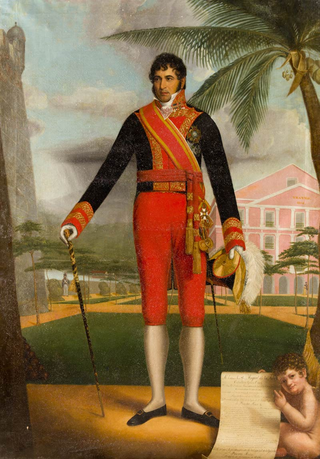
Miguel de la Torre y Pando, conde de Torrepando was a Spanish General, Governor and Captain General, who served in Spain, Venezuela, Colombia and Puerto Rico during the Spanish American wars of independence and afterwards.

Camilo García de Polavieja y del Castillo-Negrete, 1st Marquess of Polavieja was a Spanish general, born in a family of merchants. He was a competent commander, but considered as brutal as Valeriano Weyler of Cuba. He was one of the most relevant military officers of the time and a famous regeneracionista.
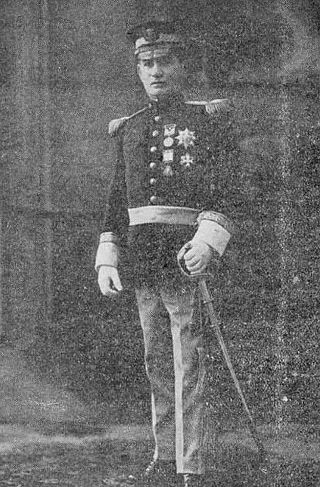
Brigadier General José Semidei Rodríguez was a Puerto Rican soldier and diplomat. He participated in Cuban independence movement that immediately preceded the Spanish–American War. Before becoming a brigadier general in the Cuban National Army, Semidei Rodríguez fought in the Cuban War of Independence (1895–1898) as a member of the Cuban Liberation Army, the rebel force which fought for Cuba's independence from Spanish colonial rule. After Cuba gained its independence he continued to serve in that country as a diplomat.

Rafael Conti Flores, also spelled "Conty" was a Colonel in the Spanish Army who was in charge of the Puerto Rican Militia in the town of Aguadilla. In 1790, he captured 11 enemy ships involved in smuggling stolen goods. In 1797, he helped defeat Sir Ralph Abercromby and defend Puerto Rico from a British invasion in Aguadilla. In 1809, he organized a military expedition fight with the aim of returning Hispaniola, which now comprises the nations of the Dominican Republic and Haiti, back to Spanish rule.
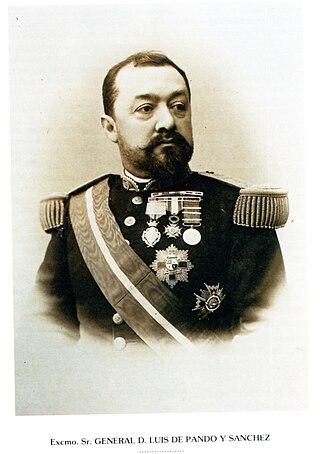
Lieutenant-General Luis Manuel de Pando y Sánchez was a Spanish general during the Spanish–American War, a Civil Governor of the Province of Santiago, Cuba. He was nominated for the Cross of San Fernando, promoted to the rank of Colonel of the Army of the field of battle by His Majesty King Alfonso XII, and the youngest General in the Spanish Army.

Joaquín Ezpeleta Enrile was a Spanish politician and Spanish Army general officer who served as the 15th President of the Spanish Senate.

Andrés González Muñoz was a Cuban politician who served briefly as the colonial governor of Puerto Rico in 1898. His father was from Venezuela and his mother was from Santiago de Cuba, the same city that Muñoz was born in. He was born in 1840 in Santiago de Cuba, Captaincy General of Cuba. He graduated in 1862 as a lieutenant from the Segovia Artillery Academy. He was promoted to lieutenant colonel for his service to Spain during the Ten Years' War, then to general after returning to Spain and fighting during the Third Carlist War. In 1895, he was named second corporal of Puerto Rico, which he held for 19 days. Afterwards, during his return to Cuba, he achieved the rank of lieutenant general. In 1898, he was appointed captain general of Puerto Rico to establish the Autonomous Charter. Upon his appointment, he left Spain for San Juan, where he arrived on January 11, 1898. However, only eight hours after the welcoming ceremony, he died of a heart attack. He was buried in the Cathedral of San Juan. Upon his death, Ricardo de Ortega y Diez became governor until Manuel Macías y Casado took over the position.

Guillermo Pintos Ledesma was a Spanish Army officer. He took part in the Third Carlist War, the Ten Years' War, the Moro conflict, and the 1895–1898 Cuban War. Promoted to brigadier general in 1905, he was killed in action at a ravine called Barranco del Lobo, during the Second Melillan campaign, leading a column of light infantry that was ambushed by Riffians at the foothills of the Mount Gurugu.

Rafael de Echagüe y Bermingham was a Spanish officer who was governor of the Philippines from 9 July 1862 to 24 March 1865.

The Battle of Montecristi was fought on May 15, 1864 in the Dominican Republic, during the Dominican Restoration War (1863–65) between Dominican forces and Spain. A Spanish force of 6,000 troops supported by 13 cannons, commanded by General José de la Gándara, appointed captain-general of Santo Domingo since March, confronted the Dominican insurgents commanded by Benito Monción. The latter, who took refuge in the town of Monte Cristi, suffered a defeat and were forced to retreat, but not without inflicting disproportionate casualties on their opponents. The future Spanish general Fernando Primo de Rivera y Sobremonte was wounded during the fighting.
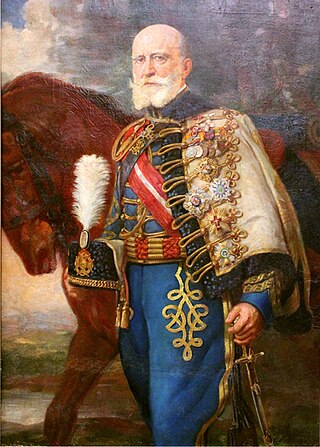
Salvador de Arizón y Sánchez-Fano (1853–1921) was a Spanish Lieutenant General who participated in the Cuban War of Independence and the Philippine Revolution. He was a member of the House of Arizón as well as the Directorate-General of the Civil Guard from June 26, 1917, to December 6, 1918.

Carlos Palanca Gutiérrez was a Spanish military commander and diplomat who reached the rank of field marshal.
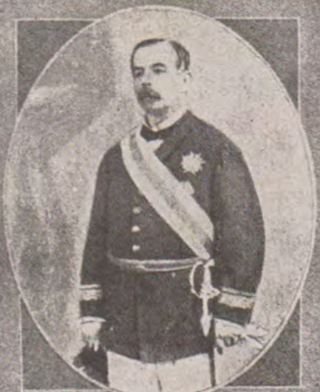
Carlos de Vargas y Cerveto was a Spanish soldier and Carlist leader. He later participated in various colonial campaigns, including serving as governor general of Santo Domingo.

Miguel Antonio de Jesús Lavastida Fernández Palomares known professionally as Miguel Lavastida, was a Dominican politician, freemason and military man whose administrative career spanned several decades and multiple roles during the First Dominican Republic.

Manuel Buceta del Villar was a Spanish brigadier who served as military governor of Málaga and Melilla. He also served in the Dominican Restoration War and the First Carlist War.